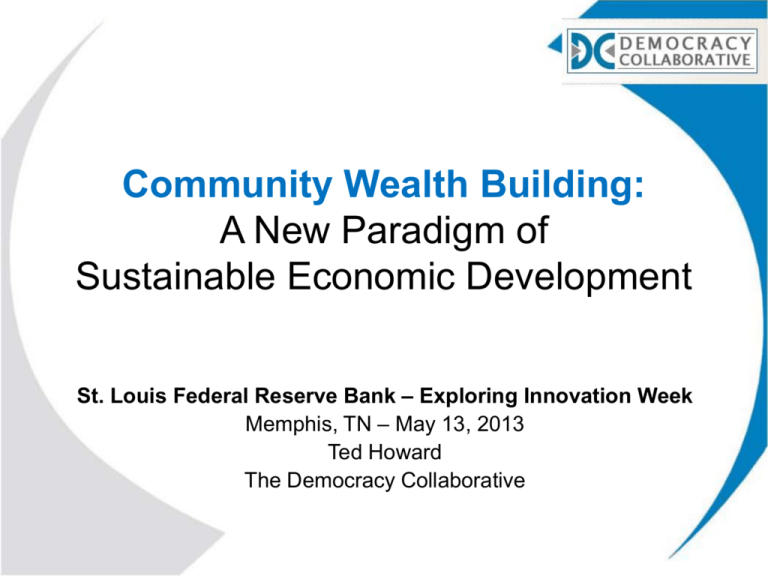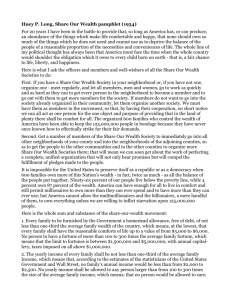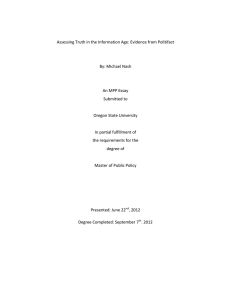Community Wealth Building - Federal Reserve Bank of St. Louis
advertisement

Community Wealth Building: A New Paradigm of Sustainable Economic Development St. Louis Federal Reserve Bank – Exploring Innovation Week Memphis, TN – May 13, 2013 Ted Howard The Democracy Collaborative Wealth Inequality in the United States U.S. Wealth (Net Worth in Trillions) 1.4 1.2 1 0.8 0.6 0.4 0.2 0 1.27 1.22 Top 400 individuals Bottom 185 million Sources—Edward N. Wolff, Recent Trends in Household Wealth in the United States, Levy Economics Institute, March 2010; Politifact, “Michael Moore Says 400 Americans Have More Wealth than Half of All Americans Combined,” http://www.politifact.com/wisconsin/statements/2011/mar/10/michaelmoore/michael-moore-says-400-americans-have-more-wealth-/ The Prevailing Economic Development Paradigm Some of its characteristics and elements include: • • • • • • • • • Subsidies and tax breaks to entice corporations to relocate ($80B) Workforce training not linked to actual jobs ($37B) Regional trickle down strategies that do not reach low- and moderate-income neighborhoods Growth & GDP – toward what end? Low-wage (non-living wage) job creation, often without benefits Exclusion of ex-offenders and others with barriers to employment Gentrification and dispersal of traditional residents “Throwaway cities” and their infrastructure Privatization of publicly owned goods What is the Community Wealth Building Paradigm? A New Approach to Economic Development that: • emphasizes democratization of wealth • focuses on place & local economy • promotes broader ownership of capital • anchors jobs locally • stops the leakage of dollars from communities • supports individual & family wealth building • reinforces stewardship over capital • generates revenues to finance public services • leverages anchor institutions for local benefit • contributes to local economic stability • total cost accounting of economic decisions Women’s Action to Gain Economic Security (CA) • Home cleaning industry notoriously pays low wages & has bad working conditions • Coop founded in 1995 • Mostly Latina immigrants who own the business • 5 coops with 100 members • Wages of $15/hour plus health • Environmentally friendly cleaning techniques New Community Corporation of Newark (NJ) • Founded in 1968 by Monsignor William Linder • Employs 1,300 residents of local neighborhoods • Community-based business ownership • Developed shopping center that houses community-owned business and services • Assets exceed $500 million • Income recycled to support day-care and after school programs, health services, Youth Automotive Training Center Washington Electric Coop (VT) The New Williamstown Solar Farm: A Sizable Presence on WEC’s Power Lines Tom Garden • Serves 10,000 customers in 41 towns in Vermont • Community owns the shares • In 2002, 1/3rd of its power came from nuclear • Today: 2/3rds of power is generated from landfill methane • 100% from renewable energy sources Market Creek Plaza (CA) • Community-designed mixed-use development; $65 million commercial and cultural complex in low-income neighborhood • Community ownership: 423 residents own shares worth $500,000; 20% of equity; will increase to 50% equity • Neighborhood foundation owns 20%; will increase to 50% • Former brownfield site; adjacent to trolley line; TOD Namaste Solar (CO) 103 “team” members; one-half are owners 4 to 1 maximum salary ratio One owner, one vote #1 market share in CO 2,000+ systems installed $15 million in revenue Pioneer Human Services - Seattle (WA) • Nonprofit founded in 1962 to serve clients – ex-offenders and drug abusers • Initially nearly 100% grant funded • Today employs 700 people, most from their client base, in network of their own for-profit businesses (hotel, catering, manufacturing) • $55 million revenue; almost no grant funding • Anchored in the community GOALS • Anchor capital so it doesn’t get up and leave • Promote asset accumulation • Stop $$ from leaking out of NE Ohio • Stabilize and revitalize neighborhoods • Develop a model for national impact MONDRAGÓN 100+ networked cooperatives For more information: www.Community-Wealth.org thoward1@umd.edu









